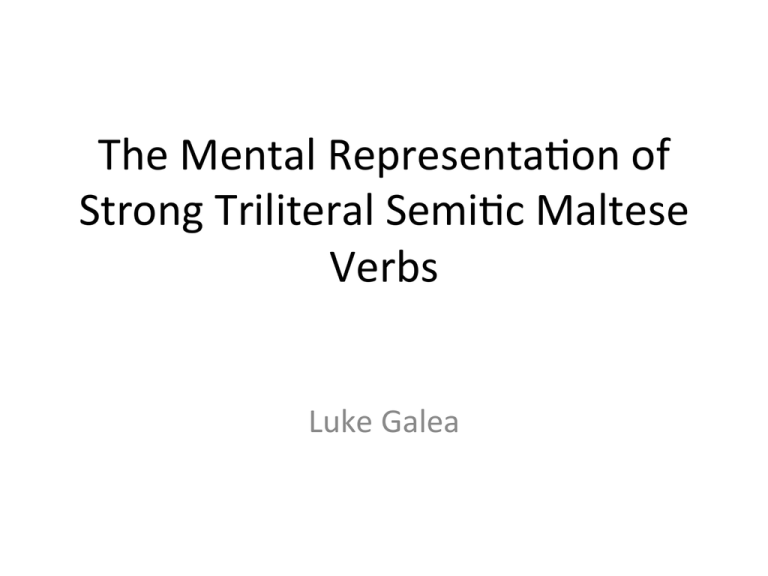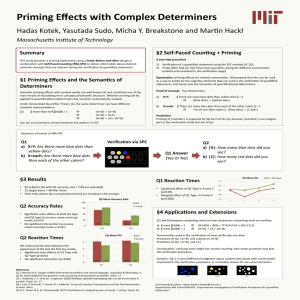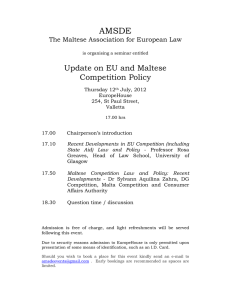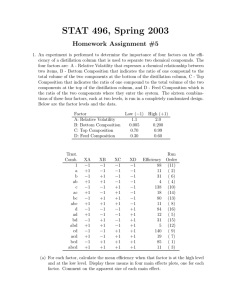Document 13170452
advertisement

The Mental Representa.on of Strong Triliteral Semi.c Maltese Verbs Luke Galea Key Points in Mental Lexicon Research • On what basis are words stored? Seman.cs? Phonology? Morphology? Orthography? • Are all words stored in the same way? Psycholinguis.c Findings • Morphological complex words are accessed via whole-­‐word route or a decomposi.onal route. • Whole-­‐word processing: search to find the word as a whole. • Decomposi.onal processing: break down words into their morphological units. • Hybrid models: incorpora.ng the two processes men.oned above. Inflec.onal Morphology • Regular and Irregular Past Tense forms in English • A dual-­‐route model (hybrid model) emerges as being the best model in capturing the difference between regular and irregular past tense forms • Regular forms (played) are decomposable forms • Irregular forms are stored as wholes (taught) • Carmazza, Laudanna and Romani (1988); Feldman, Frost and Pnin (1995); Ta\ and Zhu (1995); Pinker (1999) Deriva.onal Morphology • Difficult to define what is regular or irregular • More on a scale of how frequent and/or produc.ve deriva.onal forms are. • Marlsen-­‐Wilson et al (1996): significant priming effects were found for pairs like darkness-­‐toughness. Produc.ve deriva.onal affixes are mentally represented as separable en..es in the mental lexicon. Slower reac.on .mes for some deriva.onal forms, sugges.ng a whole-­‐word storage system. • Clahsen et al. (1999) produc.ve deriva.onal forms and regular inflec.onal forms produce priming effects – i.e. decomposable units. Hebrew Identity Condition Prime and target are the same word. hugdr - hugdr Related Condition Prime and target shared the verbal pattern, but had different roots. huklt - hugdr Control condition Primes and targets do not have similar roots or word patterns. They only share the same numbers of letters. htglsh - hugdr • Deutsch et al. (1998) report significant morphological priming between primes and targets sharing roots and word-­‐pacerns. • Frost etl al. (1997), Deutsch et al. (1998), Deutsch and Frost (2003): significant priming for primes and targets sharing a root and word-­‐pacerns . • Deutsch et al. (1998)-­‐ root and word-­‐pacern are the two underlying mental representa.on. Arabic Condi&on Prime Target [+Vowel] ?affaqa taraka [CVCCVCV] [CVCVCV] fuuzi?a faaraka [CVVCVCV] [CVVCVCV] saanada xaalafa [CVVCVCV] [CVVCVCV] [+ Skeleton] [Word Pacern] • Previous findings in Arabic show that root priming is an ac.ve element in the mental lexicon (Boudelaa and Marlsen-­‐Wilson 2001; 2004; 2005) • Significant priming effects for the [+skeleton] and [word pacern] condi.ons • Therefore, three elements underlie mental representa.on: the root, the CV-­‐ structure/skeleton and the word pacern. Maltese Regular Weak Iden&ty Root Pa3ern Unrelated kiser-­‐ KISER nkisser-­‐KISER dilek-­‐ KISER \akar-­‐ KISER break-­‐break smash–break rub-­‐break remember-­‐break beka-­‐ BEKA bekka-­‐ BEKA lewa-­‐ BEKA nqara-­‐ BEKA cry-­‐cry to make cry-­‐cry mend-­‐break to be read-­‐cry • Twist (2006): significant priming effect, but no word pacern priming effects. Psycholinguis.c Findings in Semi.c Languages Language Study Findings Hebrew Frost et al. (1997) Root Priming for nominal and verbal Deutsch et al. (1998) forms. Deutsch and Frost (2003) Word Pattern priming for verbal forms. Arabic Boudelaa & Marslen-Wilson Root priming and word pattern priming (2004) for verbal forms. The CV-structure has Boudelaa & Marslen-Wilson been found to be an important element in (2005) the mental lexicon. Also, root priming seems to be more robust than word pattern priming. Maltese Twist (2006) Root priming for verbal forms. The Study • The study was inspired by psycholinguis.cs studies carried out on Arabic and Hebrew. • Studying Semi.c Maltese verbs merit serious study because they retain the root-­‐and-­‐ pacern structure seen in Arabic and Hebrew. • Maltese overcomes the difficulty presented by Semi.c as its orthography is La.n-­‐based. • How are strong triliteral Maltese verbs stored in the Maltese mental lexicon? Are any of the units decomposable or not? • Semi.c Maltese verbs in this study have been broken down into the following elements. – The root ksr – The CV-­‐structure CVCVC – The vocalic melody CiCeC – The word pacern KISER • Twist (2006) found that the root in Maltese is an ac&ve element in lexical representa.on. • What role do the vocalic melody, CV-­‐structure and word pacern play in processing? • Following Boudelaa and Marslen-­‐Wilson (2004) – Primes and targets sharing a CV-­‐structure should yield significant effects [nasab should prime giref] – Primes and targets sharing a word pacern should yield significant effects [nkiseb should prime n.lef] BUT -­‐ primes and targets sharing the vocalic pacern shouldn’t yield any significant effects (oissed shouldn’t prime nibex) • If the CV-­‐structure and the word pacern result in significant priming effects: the Maltese mental lexicon would consist of the root, the word-­‐pacern and the CV-­‐structure. • The mental representa.on would be very similar to Semi.c verbs • If priming effects for the CV-­‐structure and word-­‐pacern are not found, this would suggest that Semi.c Maltese verbs are represented and processed differently form verbs in Semi.c languages. • Twist (2006) found significant priming effects for primes and targets sharing a root, but not the word pacern. Condi.ons Condi&on Example Condi.on 1 Prime and target share the vocalic melody, but kiser – LIBBES [+vowel] not the CV-­‐structure. CiCeC-­‐CiCCeC to divide-­‐ to liquefy Condi.on 2 Prime and target have a common CV-­‐structure, nasab – GIREF [+CV-­‐structure) but different vocalic melodies. CaCaC-­‐CiCeC to entrap – to scratch Condi.on 3 Prime and targets shared the same word-­‐pacern. gerrex – XEKKEL [word pacern] The vocalic melody and CV-­‐structure were in the CeCCeC-­‐CeCCeC same in both prime and target. to scare away – to impede Experimental Design • METHOD: – Masked Priming Paradigm (Foster and Davis 1984) – The presenta.on of a prime for about 50ms, sequen.ally inserted between a series of hash marks and the target item. – Method used to inves.gate morphological processing in both Indo-­‐European languages and Semi.c (Meunier and Marslen-­‐Wilson 2004; Verissimo and Clahsen 2009; Boudelaa and Marslen-­‐Wilson 2001, 2004, 2005). • Each par.cipant was briefed orally and further instruc.ons were given on the screen. • Par.cipants were told that they were going to see words on the screen and had to decide, by pressing a ‘yes’ or ‘no’ bucon, whether these words are Maltese words or not. • Three events happened on the screen: – 1. ############ – 2. prime (48 ms) – 3. target (word or nonword-­‐ 3000ms) • 84 par.cipants took part • Materials were used in a previous study (Ussishkin et al 2011) but were arranged to fit the condi.ons in this study. • 50% of the words the par.cipants saw were nonwords to balance the number of yes or no responses. • Verbs used were from binyamin I, II, V and VII • A root sequence (e.g. ksr) was used only once. • Fillers were added to the experiment • Only 16% of the presented items were the test items. Results Condi&on Reac&on Time (ms) [+Vowel] 666 (245.83) [+CV-­‐structure] 669 (243.30) [Word Pacern] 666 (227.45) Unrelated 694 (262) • Differences between the priming condi.ons and the unrelated condi.on can be seen. • This difference suggests that there are poten.al priming effects • ANOVA -­‐> main effect for par.cipants was significant (F(2,68)=214.21, p<.042), but main effect for items did not yield significance • In order to see where the differences are, planned comparisons were carried out. Planned Comparisons • Par.cipant analysis Test Pair df t p [+Vowel] – [Unrelated] 83 2.285 .025 [+CV-structure] – [Unrelated] 83 2.138 .035 [Word Pattern] – [Unrelated] 83 2.222 .029 Test Pair df t p [+Vowel] – [Unrelated] 41 1.642 .108 [+CV-structure] – [Unrelated] 41 2.428 .020 [Word Pattern] – [Unrelated] 41 2.031 .049 • Items analysis Mental Representa.on? • Root, CV-­‐structure and word pacern – facilita.on à salient units in lexical access. • The significant priming effects indicate that the root, word pacern and CV-­‐structure are automa.cally extracted on encountering a verbal form. • The results favour a morphological explana.on. • CV-­‐structure is a morphological unit which defines syntac.c informa.on of the word pacern. It is a templa.c sequence of consonants and vowels that convey the word’s syntac.c role. • CV-­‐structure is phonologically underspecified as only when it is realized with the root is it considered a phonological element. • Unrelated in terms of meaning-­‐ nkiser and n5lef share the CV-­‐structure and are morpho/ syntac.cally related but not seman.cally. • Semi.c Maltese verbs are mentally represented as two units: the root and the word pacern. • CV-­‐structure and the word pacern are merged into one unit: the word pacern. • The word pacern can be defined as the placeholder for the root, the deriva.onal morpheme(s) and the phonological realiza.on 1 2 ! ! /tlibbes/ WORD /libes/ /libes/ LEVEL ‘he wore’ ‘he was dressed’ /libbes/ ‘to dress someone up’ ! ! ! ! ! VERBAL ROOTS PATTERNS ! MORPHOLOGICAL CVCVC tCVCCVC CVCCVC GRF ! ! ! ! TLIBBES PRINTED /tlibbes/ ! ‘he was dressed’ ! ! KSR ! LEVEL STIMULI! LBS ! Localist Model (Deutsch et al. 2005) • Two levels of representa.on: – Lexical units consis.ng the words (the word level) – Morphological units (the morphological level) – Word is retrieved from the word level and its decomposi.on follows. – Boudelaa and Marlsen-­‐Wilson (2004) + Deutsch et al. (1998) – verbal forms are made up of an iden.fiable root and word pacern and therefore are easily decomposed. – Frost et al. (2000) and Twist (2006) Semi.c words which do not produce significant priming effects are accessed via a whole-­‐ word route. – Therefore, a dual-­‐route model is in place in our Mental lexicon. Conclusion • The elements underlying mental processing: root and word pacern • Significant priming effects for the vocalic sequence-­‐ possible reasons? References • • • • • • • • • • • • • • • • • • Boudelaa, S. and Marslen-­‐Wilson, W.D. (2001) Morphological units in the Arabic mental lexicon. Cogni5on 81(1), 65-­‐92. Boudelaa, S. and Marslen-­‐Wilson, D., W. (2004) Abstract morphemes and lexical representa.on: the CV-­‐Skeleton in Arabic. Cogni5on 92, pp.271-­‐303. Boudelaa, S. and Marslen-­‐Wilson, D., W. (2005) Discon.nuous morphology in .me: Incremental masked priming in Arabic. Language and Cogni5ve Processes 20(1),. 207-­‐260. Caramazz, A., Ludanna, A., and Romani, C. (1988) Lexical access and inflec.onal morphology. Cogni5on, 28, 207-­‐332. Clahsen, H. (1999) Lexical entries and rules of language: A mul.disciplinary study of German inflec.on. Behavioral and brain sciences, 22, 991-­‐1013. Deutsch, A. and Frost, R. (2003) Lexical organiza.on and lexical access in a non-­‐concatenated morphology. In Joseph Shimron (ed.) Language Processing and Acquisi5on in Languages of Semi5c, Root-­‐based, Morphology. Amsterdam: John Benjamins, pp. 165-­‐186. Deutsch, A., Frost, R., & Forster, K. (1998) Verbs and nouns are organized and accessed differently in the mental lexicon: evidence from Hebrew. Journal of Experimental Psychology: Learning, Memory, and Cogni5on, 24, 1238-­‐1255. Feldman, L. B., Frost, R., and Pnini, T. (1995) Decomposing words into their cons.tuent morphemes: Evidence from English and Hebrew. Journal of Experimental Psychology: Learning, Memory, and Cogni5on, 21, 947-­‐960. Forster, K. I., & Davis, C. (1984). Repe..on priming and frequency acenua.on in lexical access. Journal of Experimental Psyschology: Learning, Memory, and Cogni5on, 10, 680-­‐698. Frost, R., Forster, K. I., and Deutsch, A. (2000) Decomposing morphologically complex words in a nonlinear morphology. Journal of Experimental Psychology: Learning, Memory, and Cogni5on, 26, 751-­‐765. Frost, R., Forster, K. I., and Deutsch, A. (1997) What can we learn from the morphology of Hebrew: A masked priming inves.ga.on of morphological representa.on. Journal of Experimental Psychology: Learning, Memory, and Cogni5on, 23, 829-­‐856. Marslen-­‐Wilson, W.D. (2007) Morphological processes in language comprehension. In G. Gaskell (Ed.) Oxford Handbook of Psycholinguis5cs, pp 175-­‐193. Oxford: OUP, pp.175-­‐193. Marslen-­‐Wilson, W.D., Ford, M., Older, L., & Zhou, X. (1996) The combinatorial lexicon: priming deriva.onal affixes. In G. Cocrell (ed.), Proceedings of the 18th annual conferences of the Cogni5ve Science Meunier, F., and Marslen-­‐Wilson, W.D. (2004) Regularity and irregularity in French verb inflec.on. Language and Cogni5ve Processes, 19(4), 501-­‐580. Pinker, S. (1999) Words and Rules. The Ingredients of Language. New York, Basic Books. Ta\, M. & Zhu, X. (1995) The representa.on of bound morphemes in the lexicon: A Chinese study. In L. Feldman (ed.) Morphological aspects of language processing. Hillsdale, N.J.: Lawrence Erlbaum Associates. Twist, A. (2006) A psycholinguis5c inves5ga5on of the verbal morphology of Maltese. (Unpublished doctoral disserta.on). University of Arizona. Verissimo, J. and Clahsen, H. (2009) Morphological priming by itself: A study of Portuguese conjuga.ons. Cogni5on, 112, 187-­‐194.




